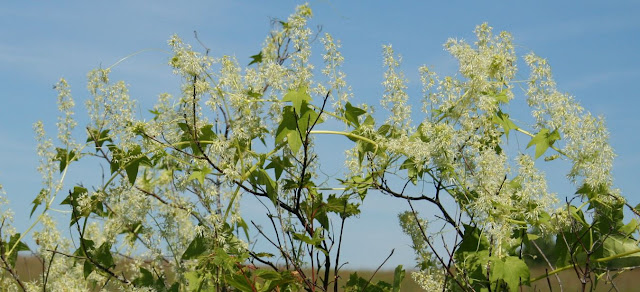 |
| Wild Cucumber, Echinocystis lobata (Michx.)
Torr. & A. Gray. This vine was growing over vegetation in a wet prairie. |
Wild Cucumber, also called Wild Balsam Apple, is a native,
annual vine of riverbanks, lakeshores, wetland edges and damp forest edges. It’s
especially evident in late summer, when its long vines produce upright racemes
of white flowers. (See Flower Parts for Plant ID for an explanation of racemes and other inflorescences.)
The vines are fast-growing, even aggressive, and where
several get started, they can swamp whatever they’re growing on, including
other plants. The sight of them covering a tree, shrub, or garden can be
alarming – some say creepy – but according to the experts, there’s little to
fear.
Because Wild Cucumber is a native plant, it’s had a long time to fit in. Throughout its natural range in most of the U.S. and Canada, it’s adapted to the other things it lives with, and they are adapted to it. The vines may overgrow and perhaps smother its host plants, but because of these mutual adaptations, overall, Wild Cucumber is not considered a threat.
 |
| A soldier beetle collecting pollen from staminate flowers. |
In other words, although Wild Cucumber can be aggressive, it’s not invasive. The latter term is reserved for plants (or animals) that are both introduced and aggressive. They’re new to an ecosystem, and for a variety of reasons, they have a competitive advantage. For example, they may grow fast, reproduce prolifically, have extended growing seasons or have few pests and diseases, so they can easily displace other plants and disrupt ecosystems.
That isn’t happening here, but in Central Europe, Wild
Cucumber is a pest. In Hungary, Poland, Austria and other countries, Wild
Cucumber was introduced as an ornamental and escaped cultivation. It
has invaded rivers valleys, lakeshores and wetlands, forming dense mats that
block light from reaching native European plants. By 2014, the plant had become
such a problem that it was considered “one of the 100 most dangerous invasive
plant species in Europe” (1).
It's possible to anticipate and even prevent such problems. Invasive
plants have some characteristics in common, and studying them can predict how a
plant will likely behave if it’s introduced outside its native range.
Here are some of the characteristics of Wild Cucumber that
make it invasive in Europe (1).
- It has a broad native range
- It can adapt to a range of environments.
- It is a human commensal, meaning it benefits from association with humans.
- It grows fast.
- It reproduces in abundance, in this case by seeds.
- Its seeds remain viable for more than a year.
Many of the same characteristics are found in other plants
that are invasive. Common Buckthorn (Rhamnus cathartica), for example,
also has a broad range – across Europe – and can grow in several habitats. This
shrub or small tree was brought to North America as a hedge plant and escaped.
A female can produce hundreds to thousands of seeds, and they are viable for up
to five years. Common Buckthorn forms dense stands that displace other plants,
and it has become a scourge of many forested ecosystems.
By comparison, Wild Cucumber is mostly harmless, at least
here. It will flower for a few more weeks before forming prickly, oval
“cucumbers” that are not edible. The seeds will shoot out of the fruit in
autumn, overwinter, and germinate in spring. That's a good time to remove the seedlings if you don't want them. Wild Cucumber is an annual, so the
parent vine will die after one season.
For more information about how to identify Wild Cucumber,
see this page
from Minnesota Wildflowers.
References
(1) CABI Invasive Species Compendium. Echinocystis lobata (wild
cucumber). Accessed August 19, 2022. https://www.cabi.org/isc/datasheet/113998




